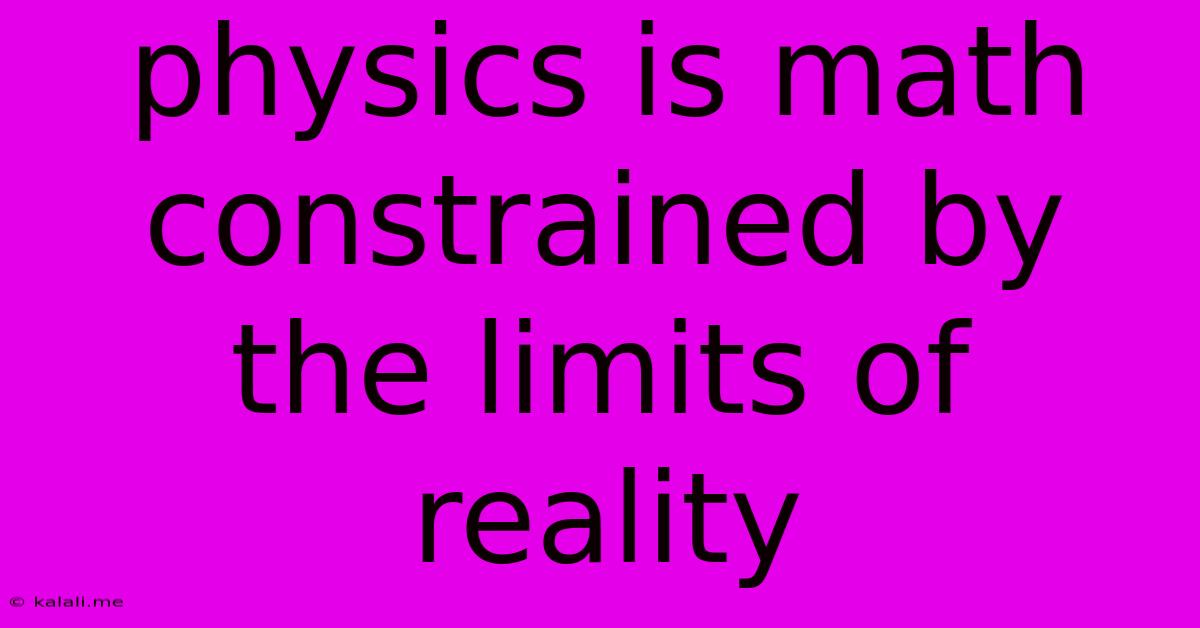Physics Is Math Constrained By The Limits Of Reality
Kalali
May 23, 2025 · 3 min read

Table of Contents
Physics: Math Constrained by the Limits of Reality
Physics, at its core, is a quest to understand the universe. We use mathematics as a powerful tool to describe and predict physical phenomena, creating elegant equations that govern everything from the smallest subatomic particles to the largest galaxies. But this elegant mathematical framework isn't boundless; it's fundamentally constrained by the stubborn realities of the universe. This article explores the fascinating interplay between the abstract world of mathematics and the concrete limitations imposed by the physical world.
The Beautiful Dance of Math and Physics
Mathematics provides the language of physics. We use mathematical models to represent physical systems, employing calculus to describe motion, differential equations to model complex interactions, and group theory to understand symmetries. The elegance and predictive power of these mathematical frameworks are undeniable. Newton's laws of motion, Maxwell's equations of electromagnetism, and Einstein's theory of relativity are all testaments to the power of mathematics in explaining the physical world. These theories make precise predictions, allowing us to build bridges, launch rockets, and understand the evolution of stars.
Where Math Breaks Down: The Limits of Reality
However, the perfect mathematical elegance often clashes with the messy reality of the universe. Several areas highlight this constraint:
1. The Problem of Measurement and Uncertainty
The Heisenberg Uncertainty Principle, a cornerstone of quantum mechanics, demonstrates a fundamental limit to our ability to precisely measure certain pairs of physical properties, such as position and momentum. This isn't a limitation of our instruments; it's a fundamental property of the universe. No matter how sophisticated our technology becomes, we will always face this inherent uncertainty, placing a natural constraint on our mathematical descriptions.
2. The Role of Approximations and Idealizations
Many physical models rely on simplifications and idealizations. For instance, we often treat objects as point masses in classical mechanics, ignoring their size and internal structure. While these approximations yield valuable insights, they inevitably deviate from reality. The more complex the system, the more likely these approximations will introduce errors, highlighting the limitations of our mathematical tools in perfectly capturing the universe's intricate details.
3. The Challenge of Emergent Phenomena
Complex systems, like the weather or the human brain, exhibit emergent properties that aren't easily predicted from the underlying microscopic interactions. While we can model individual components, capturing the collective behavior of a vast number of interacting particles remains a significant challenge. This "emergence" often escapes the reach of our current mathematical tools, emphasizing the limits of reductionist approaches.
4. The Unification Problem and Beyond the Standard Model
Physics aspires to a unified theory that explains all fundamental forces and particles. Despite significant progress, unifying gravity with the other fundamental forces (electromagnetism, the weak and strong nuclear forces) has proven incredibly difficult. This suggests the limitations of our current mathematical frameworks in fully describing the universe's fundamental constituents and their interactions. We may need new mathematical tools, perhaps beyond our current comprehension, to adequately describe these phenomena.
The Ongoing Search for Better Models
The limitations of current mathematical models in physics shouldn't be seen as a failure but rather as a driving force for further exploration. Scientists continually strive to develop more accurate and comprehensive models that better capture the complexities of the physical world. This ongoing quest pushes the boundaries of both mathematics and our understanding of the universe. The beauty of physics lies in this continuous interaction: the elegant power of mathematics striving to describe the often chaotic and unpredictable beauty of reality. This dynamic tension is what fuels the ongoing quest to unravel the mysteries of the universe.
Latest Posts
Latest Posts
-
What Does A Bad Spark Plug Look Like
May 23, 2025
-
Does An Air Pump Give Co2
May 23, 2025
-
How Many Ounces Of Cheese In A Cup
May 23, 2025
-
How To Take Off A Broken Screw
May 23, 2025
-
How To Get Gasoline Smell Off Hands
May 23, 2025
Related Post
Thank you for visiting our website which covers about Physics Is Math Constrained By The Limits Of Reality . We hope the information provided has been useful to you. Feel free to contact us if you have any questions or need further assistance. See you next time and don't miss to bookmark.